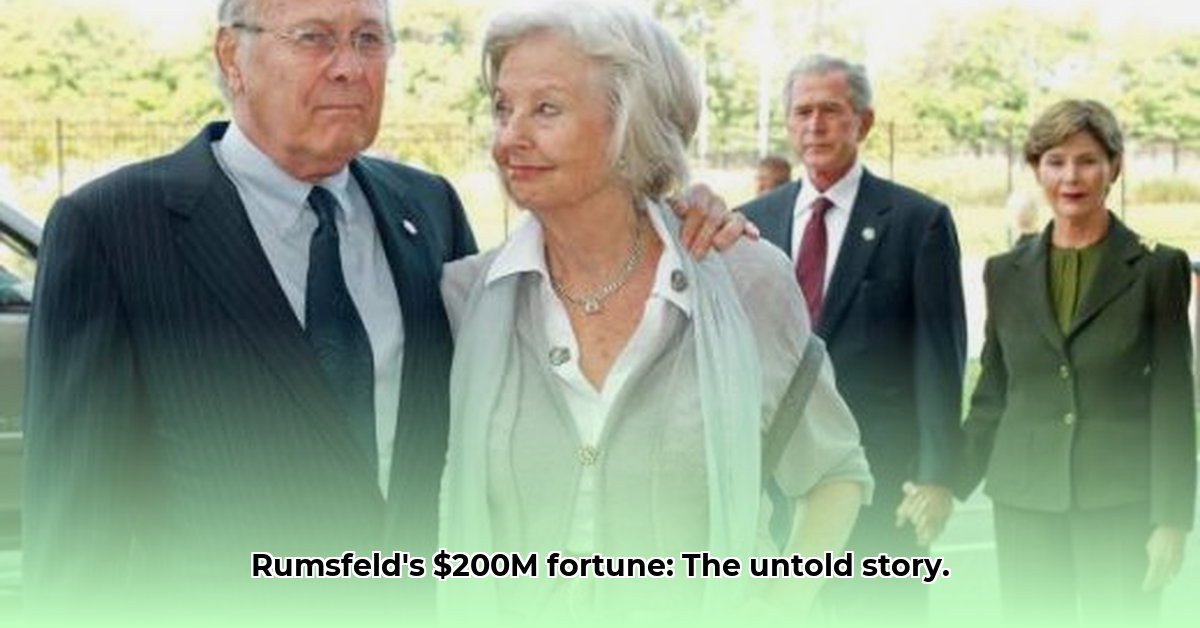
Donald Rumsfeld's name evokes strong reactions, largely due to his tenure as Secretary of Defense. But beyond the political controversies lies a compelling financial narrative: the enigma of his substantial wealth, estimated to be around $200 million at the time of his death. This article delves into the complexities of his fortune, exploring his private sector success, the challenges of accurately assessing his net worth, and the ethical considerations surrounding his transition between the worlds of business and government. We'll also offer actionable insights for researchers, policymakers, and high-net-worth individuals navigating similar paths.
From Boardrooms to Battlefields: Building a Fortune in the Private Sector
Before entering the political arena, Rumsfeld built a highly successful career in the private sector. He wasn't simply an employee; he held leadership positions at significant companies including G.D. Searle & Company (prior to its acquisition by Monsanto), General Instrument Corporation, and Gilead Sciences. His ability to revitalize struggling businesses and increase their market value significantly contributed to his considerable wealth accumulation. This period formed the foundation of his immense fortune, showcasing his financial acumen and entrepreneurial skill. This business success, however, would later intersect with his public service, raising complex questions.
Public Service, Private Wealth: Navigating the Intricacies
Rumsfeld's service as Secretary of Defense under Presidents Ford and George W. Bush introduced significant complexity to his financial profile. Estimates of his net worth varied dramatically throughout his career, ranging from a low of $50 million to figures exceeding $200 million. This discrepancy stems primarily from the difficulty in accurately valuing his investments, many of which were in less transparent vehicles like private equity partnerships. Even after leaving office in 2006, with an estimated net worth of around $127 million, the precise figure remained elusive. This highlights the challenges inherent in assessing the wealth of individuals with diverse and complex financial holdings. How can we accurately determine the true value of such portfolios, and what are the implications for transparency and accountability in government?
The Numbers Game: Unpacking the Difficulties of Valuation
Determining Rumsfeld's precise net worth presents a significant challenge. The inconsistencies in reported figures reflect the inherent difficulties in evaluating privately held investments and intricate financial structures. Assets such as private equity stakes lack readily available market values, making precise estimations difficult, even for financial experts. This problem isn't unique to Rumsfeld; it's a common hurdle in assessing the wealth of individuals with highly diversified portfolios. This inherent opacity raises questions about the accuracy and reliability of publicly available financial information for high-net-worth individuals. What can be done to improve the transparency and accuracy of financial reporting in such cases?
Ethical and Legal Considerations: Potential Conflicts of Interest
Rumsfeld's transition from the private to the public sector raises crucial ethical questions. The process of divesting assets to avoid conflicts of interest proved exceptionally challenging due to the complexity of his holdings. Reports indicate he spent approximately $60,000 on accounting services to navigate this complex legal and financial landscape. This highlights the significant hurdles high-net-worth individuals face when entering public service and raises questions about the adequacy of current regulations in preventing potential conflicts of interest between personal financial interests and government duties. How robust are existing regulations, and are reforms needed to ensure greater transparency and accountability?
Actionable Insights: Lessons Learned and Strategies for Reform
Rumsfeld's financial journey offers valuable lessons for multiple stakeholders:
Researchers/Scholars: Further research is needed to analyze the correlation between private sector success and post-government wealth, tracking wealth changes across different career paths over time. This could provide valuable insights into financial trends among public officials.
Government Ethics Offices: Streamlining asset disclosure forms and improving clarity, while strengthening guidelines and enforcement for complete divestment, is crucial. Providing additional support to individuals navigating complex divestment processes is also essential.
High-Net-Worth Individuals: Proactive financial planning for divestment, seeking expert legal and financial counsel, and exploring strategies like blind trusts are essential for minimizing potential conflicts of interest.
Navigating the Risks: A Risk Assessment Matrix
Understanding the risks associated with high-net-worth individuals in public office is paramount for maintaining public trust. The following matrix summarizes potential risks and mitigation strategies:
| Risk Category | Specific Risk | Probability | Impact | Mitigation Strategy |
|---|---|---|---|---|
| Financial Transparency | Inaccurate asset declarations due to complex holdings | Medium | High | Stricter reporting regulations; independent audits; clearer guidelines |
| Conflicts of Interest | Personal investments influencing policy decisions | Low | High | Mandatory and timely divestment; stronger ethics training; independent oversight |
| Public Perception | Negative public opinion due to wealth disparity | Medium | Medium | Transparency initiatives; clear communication of financial conflicts |
The case of Donald Rumsfeld underscores the complexities of accurately assessing the wealth of high-profile individuals and the necessity for improved transparency, robust ethics regulations, and clearer guidelines for those transitioning between the private and public sectors. Continued research and refinement of these processes are essential for maintaining public trust in the integrity of government officials.